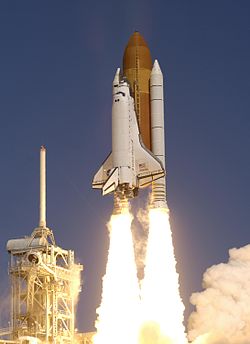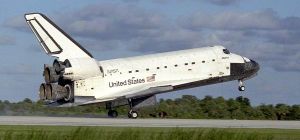Space Shuttle Atlantis
This STS-117 23:37:59 GMT, 8 June 2007. documents a current or recent spaceflight. Details may change as the mission progresses. Initial news reports may be unreliable. The last updates to this STS-117 23:37:59 GMT, 8 June 2007. may not reflect the most current information. For more information please see WikiProject Spaceflight. |
 Atlantis before the launch of STS-115, August 29, 2006. | |
| Construction number | OV-104 |
|---|---|
| Country | United States |
| Contract award | 29 January 1979 |
| Named after | R/V Atlantis (AGOR-25) |
| Status | Operational |
| First flight | STS-51-J 3 October 1985 - 7 October 1985 |
| Last flight | STS-115 9 September 2006 - 21 September 2006 |
| No. of missions | 27 |
| Crew members | 167 |
| Days spent in space | 243.992 days |
| No. of orbits | 3,654 |
| Distance travelled | 144,694,078 km + STS-115 |
| Satellites deployed | 14 |
| Mir dockings | 7 |
| ISS dockings | 7 |
Space Shuttle Orbiter Atlantis (NASA Orbiter Vehicle Designation: OV-104) is one of the fleet of space shuttles belonging to the U.S. National Aeronautics and Space Administration (NASA). It was the fourth operational shuttle built. Following the destruction of Challenger and Columbia, it is one of the three fully operational shuttles remaining in the fleet. The other two are Discovery and Endeavour. After it completes STS-125, the final Hubble Space Telescope service mission, Atlantis is scheduled to be the first shuttle retired from the fleet. A petition is circulating to convince NASA to retire the Atlantis at its birthplace at Palmdale Airport's Plant 42 in Heritage Airpark. [1]
Operational history
Atlantis made its first flight in October 1985, conducting classified military activities, one of five such flights. In 1989, Atlantis deployed two planetary probes, Magellan and Galileo, and in 1991, it deployed the Compton Gamma Ray Observatory.
Beginning in 1995, Atlantis made seven straight flights to the Russian space station Mir. On the second Mir flight, it delivered a docking module, and on the subsequent flights, it conducted astronaut exchanges.
From November 1997 to July 1999, Atlantis underwent refitting operations, with about 165 modifications made to the shuttle, including the installation of the Multifunction Electronic Display System, or glass cockpit. It has made six flights since then, all involving assembly activities at the International Space Station.
In October 2002, Atlantis and the six-person crew completed an 11-day mission to the International Space Station that involved three space walks.
NASA scheduled the 27th launch for Atlantis for September 2005, during the window of September 9 - 24. It was ruled unsafe to fly the mission and the launch window was missed, due to the complications during Discovery's launch of mission STS-114 and NASA's subsequent suspension of all future shuttle launches. Atlantis was the designated STS-300 rescue orbiter for the STS-114 mission. Atlantis was scheduled to fly the STS-121 mission, but it was decided that Discovery would fly the mission instead.
After a four-year-halt she went back in orbit along with six astronauts on STS-115, carrying the P3/P4 truss segments and solar arrays.
Atlantis is scheduled for the next Space Shuttle mission, STS-117. Due to damage from a hail storm on February 26 2007 launch has been delayed until June 8[1]
Atlantis is scheduled to be retired in 2008 after its last scheduled flight, STS-125, the final servicing mission to the Hubble Space Telescope.[2] It would be used to supply parts for Discovery and Endeavour through the anticipated end of the Space Shuttle program in 2010. Atlantis was chosen for early decommissioning to avoid a costly overhaul process that was slated to begin in 2008.[3]
Flights

Space Shuttle Atlantis has completed 27 flights, spent 220.40-days in space, completed 3,468 orbits, and flown 89,908,732 miles in total, as of September 2006.
| Date | Designation | Notes |
|---|---|---|
| 1985 October 3 | STS-51-J | First Atlantis mission; mission dedicated to Department of Defense. |
| 1985 November 26 | STS-61-B | 3 communications satellites deployed: MORELOS-B, AUSSAT-2 and SATCOM KU-2. |
| 1988 December 2 | STS-27 | Mission dedicated to Department of Defense. |
| 1989 May 4 | STS-30 | Deployed Magellan probe. |
| 1989 October 18 | STS-34 | Deployed Galileo probe. |
| 1990 February 28 | STS-36 | Mission dedicated to Department of Defense. |
| 1990 November 15 | STS-38 | Mission dedicated to Department of Defense. |
| 1991 April 5 | STS-37 | Deployed Compton Gamma Ray Observatory. |
| 1991 August 2 | STS-43 | Deployed TDRS-5. |
| 1991 November 24 | STS-44 | Mission dedicated to Department of Defense. |
| 1992 March 24 | STS-45 | Carried Atmospheric Laboratory for Applications and Science (ATLAS) mission 1. |
| 1992 July 31 | STS-46 | Deployed ESA European Retrievable Carrier and NASA Tethered Satellite System. |
| 1994 November 3 | STS-66 | Carried ATLAS mission 3. |
| 1995 June 29 | STS-71 | First shuttle docking with space station Mir. |
| 1995 November 12 | STS-74 | Carried docking module to Mir. |
| 1996 March 22 | STS-76 | Rendezvous with Mir, including crew transfer of Shannon Lucid. |
| 1996 September 16 | STS-79 | Rendezvous with Mir, including crew transfer of Shannon Lucid and John Blaha. |
| 1997 January 12 | STS-81 | Rendezvous with Mir, including crew transfer of John Blaha and Jerry Linenger. |
| 1997 May 15 | STS-84 | Rendezvous with Mir, including crew transfer of Jerry Linenger and Michael Foale. |
| 1997 September 25 | STS-86 | Rendezvous with Mir, including crew transfer of Michael Foale and David A. Wolf. |
| 2000 May 19 | STS-101 | International Space Station assembly mission (re-supply ISS). |
| 2000 September 8 | STS-106 | International Space Station assembly mission (re-supply ISS). |
| 2001 February 7 | STS-98 | International Space Station assembly mission (carried and assembled the Destiny Laboratory Module). |
| 2001 July 12 | STS-104 | International Space Station assembly mission (carried and assembled the Quest Joint Airlock). |
| 2002 April 8 | STS-110 | International Space Station assembly mission (carried and assembled the S0 truss segment). |
| 2002 October 7 | STS-112 | International Space Station assembly mission (carried and assembled the S1 truss segment). |
| 2006 September 9 | STS-115 | International Space Station resupply and construction (P3 and P4 truss segments). |
| NET 2007 June 8 | STS-117 | International Space Station resupply and construction (S3 and S4 truss segments). [1] |
Aging
NASA announced that 24 helium and nitrogen gas tanks, named Composite Overwrap Pressure Vessels, in the Space Shuttle Atlantis are older than their designed lifetime (designed for 10 years, later cleared for another 10 years but in service now for 22 years). NASA said it cannot guarantee any longer that the vessels on Space Shuttle Atlantis will not burst or explode under full pressure. Therefore, the vessels will only be at 80 percent pressure as close to the launch contdown as possible, and the launch pad will be cleared of all but essential personnel when pressure is increased to 100 percent. A launch pad explosion could damage parts of the shuttle and even wound or kill ground personnel. An in-flight failure fo the vessels could even result in the loss of the orbiter and its crew. Because the original vendor is no longer avaliable, the vessels cannot be rebuilt before 2010 (when the shuttles are no longer in operation). NASA analyses originally assumed that the vessels would leak before they burst, but new tests showed, that they would burst before they leak. The new launch procedure, of clearing the launch pad of all but the essential personnel and pressurizing the tanks to 100 percent as late as possible, will now be conducted at all following Atlantis launches if no other resolution is found. Atlantis will have to launch three more times in this setting. It is unclear, but possible, that Space Shuttle Discovery, which will launch another 5 or 6 times, has the same problems and if the same launch procedure needs to be conducted with Discovery. Since Space Shuttle Endeavour, which will launch another 6 or 7 times, was built much later, around 1990, it is possible that Endeavour does not have the same problem. [2]
Popular culture

- In the film Deep Impact the crew used the Space Shuttle Atlantis to get to the mission craft, Messiah.
- In the game The Dig, an unnamed shuttle participates in the mission of firing the asteroid. However in the game demo, the name "Atlantis" is mentioned.
- In the film Armageddon, the Space Shuttle Atlantis is destroyed in orbit at the beginning of the film by a meteor shower.
- In the episode of the animated show Recess which was called "Space Cadet," the class watches a space shuttle launch. The vehicle is Atlantis.
- In the movie SpaceCamp, the space shuttle Atlantis is featured. The children were onboard the shuttle during an engine test when one of the Space Shuttle Solid Rocket Boosters was ignited.
- In the free space simulator Orbiter created by Martin Schweiger, Atlantis is the default space shuttle you can pilot.
- In the PlayStation game “Treasures of the Deep,” the player goes on a mission to destroy the shuttle's remains after it sinks in the Mariana Trench.
- In the Tom Clancy novel Red Storm Rising Atlantis was pulled off the launch pad just before a scheduled mission to allow the military to switch out her original payload with additional reconnaissance satellites just before the outbreak of war with the Soviet Union.
- In a Bill Nye the Science Guy Episode "Space Exploration," Atlantis as well as Columbia make an appearance.
See also
Notes
- ^ "Hail damage postpones shuttle launch". CNN.
- ^ Template:Cite web url=http://www.nasaspaceflight.com/content/?cid=4987
- ^ "NASA To Retire Space Shuttle". CBS News. 2006-02-21. Retrieved 2006-08-31.
{{cite web}}: Check date values in:|date=(help)



